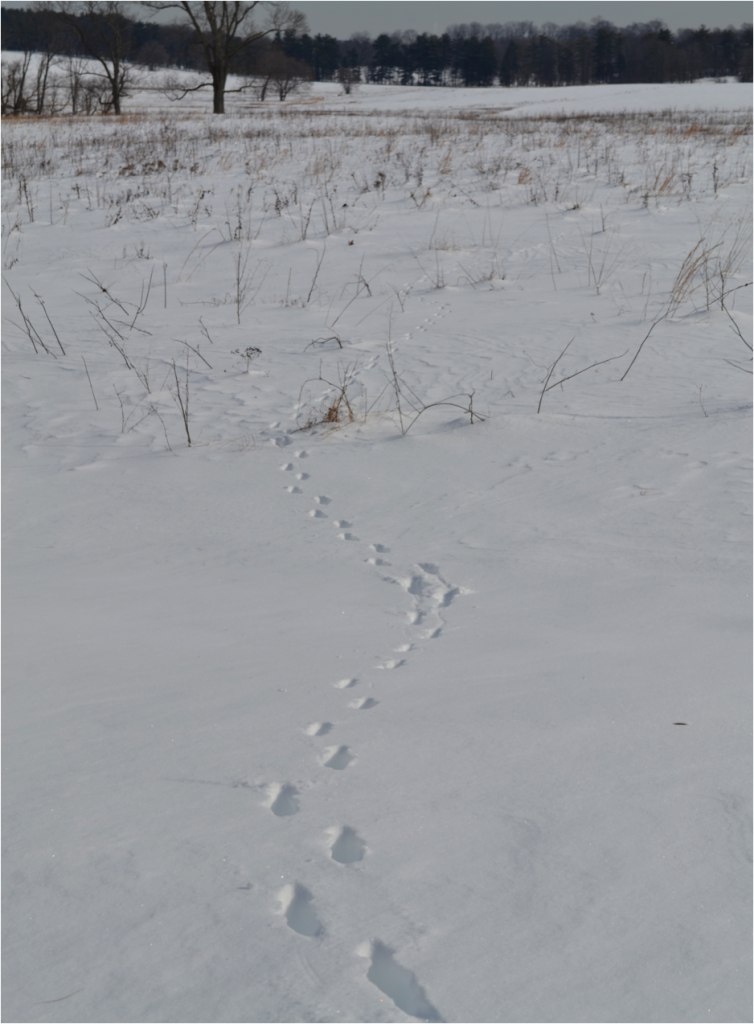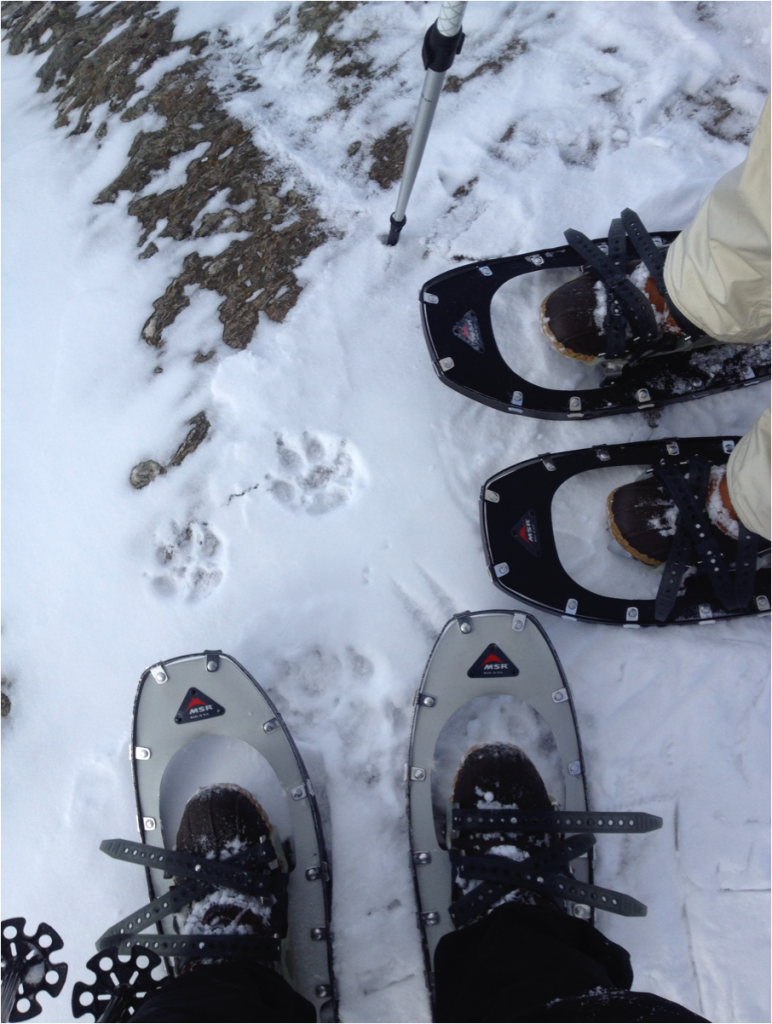Imagine yourself hiking alone through freshly fallen snow in the backcountry. There are no sounds of civilization—not even a plane overhead. You come across an animal’s track…Who left it behind? And, where were they going? Today, my goal is to provide you with some basic information, so you can get started on your own winter wildlife tracking.
Here’s a little bit about my wildlife tracking experience: While doing my undergrad at the University of Vermont, I took a few semesters of winter wildlife tracking. The courses were based out of a large natural area in the woods of Northern Vermont. I also studied ecology, landscape natural history, natural resources, wildlife conservation, biology, and wilderness conservation. Despite all my studies, I would not call myself an expert tracker—not even in the slightest! I am just an amateur who enjoys exploring in the woods.

Pick where you want to go
I recommend choosing somewhere a little off the beaten path: the fewer human disturbances, the better. With that in mind, it’s safer to find some place you’re familiar with and wouldn’t mind stepping off the trail a bit.
My favorite place to track in Vermont is on the Nebraska Notch Trail on the backside of Mt. Mansfield in Stowe. In Pennsylvania, I love going to Valley Forge National Historic Park after a big snowstorm. The most important thing is to find a place where you can be comfortable!
Timing is important
Most animals are active at dawn and dusk, which is known as being crepuscular (in case you’d like to impress friends with a cool, new vocabulary word). I recommend going out first thing in the morning, a time of day when the animals you are seeking are less likely to have been disturbed and before tracks can be muddled by humans, pets, or the elements. I have had my most successful tracking adventures at 7 a.m. on a Saturday morning.
What to Bring:
- Snowshoes: I have a pair of MSR Lightning Ascents. They are pretty technical, with a full crampon that makes for a good all-around snowshoe.
- Trekking poles
- Hydro Flask: Full of hot coffee or tea to keep you warm as you meander about.
- Waterproof boots: I wear my Oboz Bridgers, but heavier-insulated winter boots might keep you even warmer if it’s particularly cold.
- Hand warmers
- Camera
- Binoculars
- Animal track guide
- Backpack: EMS’ Sector Series 22L is a great lightweight option.
- Lunch, snacks, and water

Tracking Tips
The first thing I do when looking for tracks is take 10 to 20 minutes to tune into my senses. I was taught to find a spot in the woods just off the trail where I could sit in the snow and use each of my five senses in turn.
First, I sit with my eyes closed and just listen: to the wind, to the sounds the trees make, and to the sound of my own breath. While listening to all of these different sounds, be sure to make note of them in your head. Consider their pitch, duration, repetition, tone, sequence, etc.
Next, take another five minutes or so, still with your eyes closed, to take in the smells around you. After that, open your eyes and make this next five about taking in your surroundings. This time, try not to focus in on any one thing but instead to take in many at once. Finally, combine all the senses and take in the environment as a whole for a few minutes.
The tracks you will look for are disturbances made into the baseline of the natural environment. When looking at your location’s big picture, all the components that are typically present in it—like a downed tree, the trail, the snow on the ground, the sun, the fallen leaves, and grass poking through—are aspects of the “baseline.” The baseline is the normal environment in front of you, minus any impact done by animals or humans, such as a stick nibbled on by a deer, a nut chewed by a squirrel, or a branch snapped by a boot. These are disturbances, because they interrupt what is normally present.
When wildlife tracking, the key is to step back to try to see the bigger picture of what is in front of you, so that disturbances become more obvious. Tracks are just a small disturbance into the greater picture, or the baseline, and they are the evidence left behind of animals that were once there.
Once you are ready to begin tracking, a good place to start is up high on a ridge or down low in a valley. Predators like to be at a higher elevation for a good perspective when stalking smaller prey. Valleys and low areas tend to be animal highways consistently being walked, trotted, crawled, hopped, and run through.
Walk around for a while, keeping the big picture of the entire environment in mind as you do so. Your body may be up on the ridgeline, but let your mind wander to those valleys. Patience is the name of the game here, and tracking isn’t something that can be rushed. Take your time, and when you do find some tracks, stick to them to see where the adventure leads!
Tracking Facts
- Tracks made in direct sunlight crystallize and turn icy due to the melting process. They also crisp up and harden where the greatest amount of force was made in the mark. For example, pressure put into the ball of the foot is where there will be a significant amount of icy change comparable to the track’s edge. In addition, watch out for sunlight. It can create shadows that may result in misrepresentation within the track. Tracks that are made under cover and do not receive direct sunlight will have less melting and less iciness.
- When I find a new track that I am uncertain of, I like to take my glove off and feel the edges of it. See where the deepest parts are and feel how icy the track is. The track’s age can be determined by how icy it has become. The icier it is, the older and more forcefully the animal made the track.
- Another thing I like to take notice of is how far apart the tracks are. Was the animal running, hopping, walking, or stalking? If it’s a squirrel headed for a tree and the tracks are fairly spaced, maybe it was getting there in a hurry, because it was being chased.
- When trying to decipher who left the track, I revert to my handy pocket guide! It’s fun and exciting to try to identify who left the track, and it gives clear tips on what characteristics to look for in the tracks you’ve found.
Helpful Identification Tips
Fisher
This carnivore, part of the weasel family, is the size of a large house cat. Tracks are 2 in. by 2 in. generally, and their patterns commonly feature a bounding gate. They have five toes measuring 3 in. wide by 4.5 in. long.
Red Fox
This carnivore’s tracks, with four toes, can be found in a nearly straight line. Oval tracks measure 2 in. to 3 in. long and usually show small triangular footpads.
Coyote
This carnivore, with four toes, has oval tracks measuring 2.5 in. to 3.5 in. long, and they usually show footpads. They typically walk or trot in an alternating pattern.
Black Bear
This five-toed omnivore has front tracks measuring 5 in. by 5 in. and rear paw tracks measuring 7 in. by 5 in. These bears generally walk on the soles of their feet and tend to follow preexisting trails and roads. Additionally, you may find tree markings nearby.
Moose
This herbivore has tracks measuring 5 in. to 6 in. in length and 3 in. to 4 in. wide and usually featuring prominent dewclaw imprints. You may also see a “heart”-shaped imprint left behind.
Turkey
This herbivore with three toes has tracks measuring 3.5 to 4.5 in. long by 3.75 to 4.25 in. wide. Their stride is generally a straight line, with tracks 8 to 14 in. apart, depending on its speed.
Troubleshooting: 404 tracks not found!
What do you do when you hit a wall and can’t find the next track? I think the biggest part is making sure you are seeing the whole baseline. I know that when I get excited, I can become too focused on one track or even one line of tracks. As a result, I end up losing sight of things, and then it seems impossible to find more tracks or even where they were headed. When you can’t find the next track, retrace to where you started: Look at the initial track, then back up and take in the whole baseline again, and follow those disturbances to the baseline and see where they lead.
If the track still seems to end, examine why: maybe it ends on the ground there and picks up on a tree instead, maybe the animal changed direction abruptly and the tracks head in an unforeseen direction, or maybe the rest of the tracks just can’t be found. Just because they’re lost or unseen does not mean they’re not there. The key part of reacting to situations like this is to remain calm. So, keep at it, and remember that the adventure of wildlife tracking is in finding a brand new set to follow.

Maddy Jackson
Maddy is a Physical Therapist working in the Philadelphia suburbs. She grew up going camping, hiking, kayaking and anything and everything outdoors with her family, which she continues to do today! She has a 7 year old English Springer Spaniel named Ben Franklin who is incredibly active and enjoys hiking and swimming. Her favorite hike would have to be Cadillac Mountain in Acadia National Park—the views are stunning!




